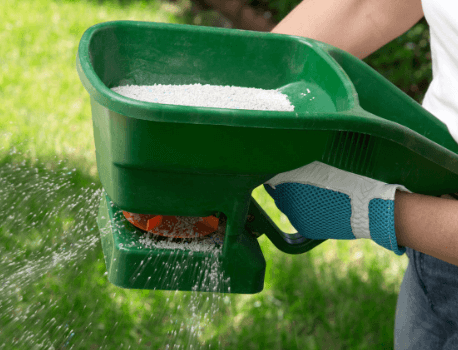The Ultimate Guide to Shopping for Lawn Fertilizer

A vibrant, healthy lawn starts with nutrient-dense soil that provides what it needs. Grass absorbs nutrients from the soil, so soil lacking in nutrients results in nutrient-deficient grass that can’t stand up to diseases and pests. Using the proper fertilizer for your specific grass will help it grow strong and healthy while developing deep, strong roots. A strong, healthy lawn is the best way to prevent weeds and pests that can damage grass.
When it’s time to purchase fertilizer, you’ll notice there are a lot of different choices. Unfortunately, there is no one size fits all approach to feeding your lawn. Different grasses have different requirements, and the soil can vary with location. You may choose a weed and feed approach, or your lawn may have different needs. Here’s your ultimate guide to shopping for the best stuff to feed your lawn consistently.
Soil Test Kit
It is highly recommended that you first use a soil test kit to find out exactly what type of soil you have and which nutrients may be lacking. A soil test kit can easily be completed at home, and the results are a wealth of information. You’ll find out if your soil is acidic or alkaline and which specific nutrients you may need to feed your lawn, as different grasses have different requirements.
Granular or Liquid
Next, you’ll need to decide between a granular or a liquid approach. This really boils down to personal choice because there are advantages to each. A granular approach is typically recommended for beginning lawn enthusiasts because it is easier to store and apply. Granular products feed lawns consistently and should be replied to every 4 to 6 weeks. It is also easier to prevent over-application with granular products, which should be applied with a drop or broadcast spreader. Many products also come premixed for a weed and feed approach to your lawn care.
Liquid products tend to work much faster, usually within a couple of days. They should be applied with a backpack sprayer using a turf dye to prevent over-application. The dye dissipates within a couple of days, but it is crucial as over-application of liquid fertilizer can kill the grass. Liquid products should be applied up to twice per month during peak growing season along with regular mowing and watering for best results.
Reading Labels
The main components in many lawn fertilizers are nitrogen (N), phosphorous (P), and potassium (K). These nutrients are essential for healthy grass and are deficient in many soils. You’ll likely see numbers such as 20-10-10 listed on the bag. They are always listed in the order of nitrogen, phosphorous, and then potassium. If you see these numbers listed on a 50lb bag of fertilizer, then you know it contains 20 percent nitrogen and 10 percent each of phosphorous and potassium. This translates to 10 pounds of nitrogen, 5 pounds of phosphorous, and 5 pounds of potassium. Understanding these labels will help you purchase products with the exact nutrient your lawn needs to thrive.
Start Your Lawn Care Today
If you are ready to start your lawn care routine, it’s best to purchase a soil test kit to find out exactly which nutrients may be lacking in your soil. Then decide whether you want to choose a granular or a liquid product approach to fertilize your lawn. Once you’ve made those decisions, be sure you have the right tools for application, and you understand how to read the product labels. If you need help, ask a professional because a trial-and-error approach can damage your lawn. Feed your lawn properly and become the envy of the neighborhood with a beautiful golf course lawn.





